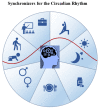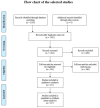Biological Rhythm and Chronotype: New Perspectives in Health
- PMID: 33804974
- PMCID: PMC8063933
- DOI: 10.3390/biom11040487
Biological Rhythm and Chronotype: New Perspectives in Health
Abstract
The circadian rhythm plays a fundamental role in regulating biological functions, including sleep-wake preference, body temperature, hormonal secretion, food intake, and cognitive and physical performance. Alterations in circadian rhythm can lead to chronic disease and impaired sleep. The circadian rhythmicity in human beings is represented by a complex phenotype. Indeed, over a 24-h period, a person's preferred time to be more active or to sleep can be expressed in the concept of morningness-eveningness. Three chronotypes are distinguished: Morning, Neither, and Evening-types. Interindividual differences in chronotypes need to be considered to reduce the negative effects of circadian disruptions on health. In the present review, we examine the bi-directional influences of the rest-activity circadian rhythm and sleep-wake cycle in chronic pathologies and disorders. We analyze the concept and the main characteristics of the three chronotypes.
Keywords: chronic diseases; chronotype; circadian rhythm; circadian typology; health; melatonin; rest–activity; sleep; social jet lag.
Conflict of interest statement
The authors declare no conflict of interest.
Figures
Similar articles
-
Sleep timing, chronotype and social jetlag: Impact on cognitive abilities and psychiatric disorders.Biochem Pharmacol. 2021 Sep;191:114438. doi: 10.1016/j.bcp.2021.114438. Epub 2021 Feb 2. Biochem Pharmacol. 2021. PMID: 33545116 Review.
-
Chronotype influences activity circadian rhythm and sleep: differences in sleep quality between weekdays and weekend.Chronobiol Int. 2015 Apr;32(3):405-15. doi: 10.3109/07420528.2014.986273. Epub 2014 Dec 3. Chronobiol Int. 2015. PMID: 25469597
-
Human chronotype is determined in bodily cells under real-life conditions.Chronobiol Int. 2013 May;30(4):607-17. doi: 10.3109/07420528.2012.754455. Epub 2013 Feb 27. Chronobiol Int. 2013. PMID: 23445508
-
Time course of neurobehavioral alertness during extended wakefulness in morning- and evening-type healthy sleepers.Chronobiol Int. 2011 Jul;28(6):520-7. doi: 10.3109/07420528.2011.590623. Chronobiol Int. 2011. PMID: 21797780
-
Attention to Innate Circadian Rhythm and the Impact of Its Disruption on Diabetes.Diabetes Metab J. 2024 Jan;48(1):37-52. doi: 10.4093/dmj.2023.0193. Epub 2024 Jan 3. Diabetes Metab J. 2024. PMID: 38173377 Free PMC article. Review.
Cited by
-
Changes in Sleep Quality, Sleep Duration, and Sickness Absence: A Longitudinal Study with Repeated Measures.Healthcare (Basel). 2024 Jul 11;12(14):1393. doi: 10.3390/healthcare12141393. Healthcare (Basel). 2024. PMID: 39057537 Free PMC article.
-
Chronotype as a predictor of athletic performance in youth with mild intellectual disabilities.Front Physiol. 2024 Jul 5;15:1405595. doi: 10.3389/fphys.2024.1405595. eCollection 2024. Front Physiol. 2024. PMID: 39035451 Free PMC article.
-
Bright Morning Lighting Enhancing Parasympathetic Activity at Night: A Pilot Study on Elderly Female Patients with Dementia without a Pacemaker.Healthcare (Basel). 2023 Mar 8;11(6):793. doi: 10.3390/healthcare11060793. Healthcare (Basel). 2023. PMID: 36981450 Free PMC article.
-
Chrono-optimizing vaccine administration: a systematic review and meta-analysis.Front Public Health. 2025 Apr 7;13:1516523. doi: 10.3389/fpubh.2025.1516523. eCollection 2025. Front Public Health. 2025. PMID: 40260163 Free PMC article.
-
Association of chronotype and sleep behaviors with mental well-being, eating behaviors, and adiposity traits: a cross-sectional study among a sample of urban Malaysian adults.BMC Public Health. 2025 Mar 27;25(1):1168. doi: 10.1186/s12889-025-22340-z. BMC Public Health. 2025. PMID: 40148846 Free PMC article.
References
-
- Roveda E., Montaruli A., Galasso L., Pesenti C., Bruno E., Pasanisi P., Cortellini M., Rampichini S., Erzegovesi S., Caumo A., et al. Rest–activity Circadian Rhythm and Sleep Quality in Patients with Binge Eating Disorder. Chronobiol. Int. 2018;35:198–207. doi: 10.1080/07420528.2017.1392549. - DOI - PubMed
Publication types
MeSH terms
Substances
LinkOut - more resources
Full Text Sources
Other Literature Sources



